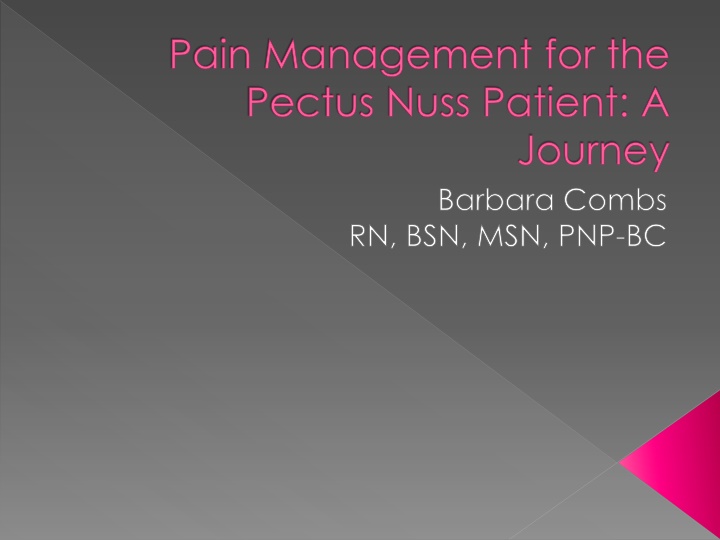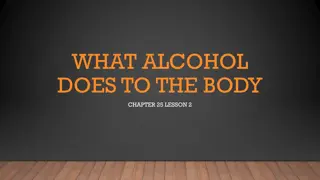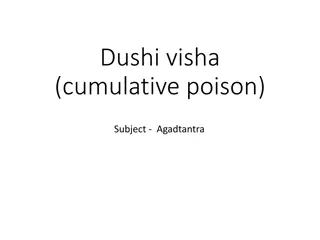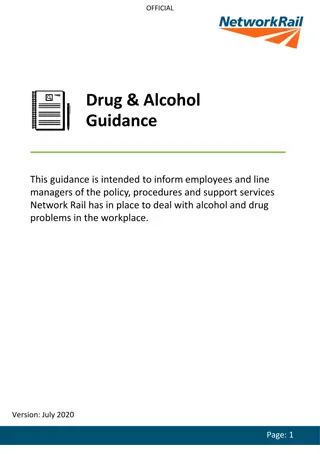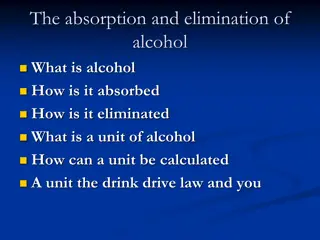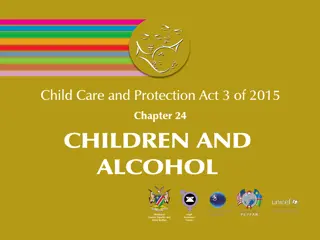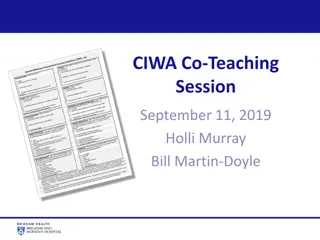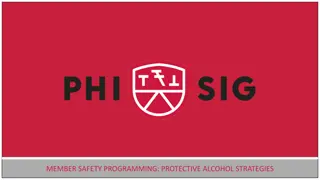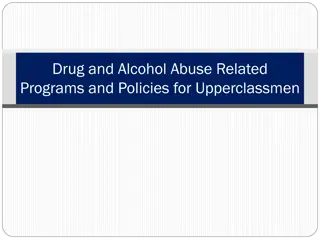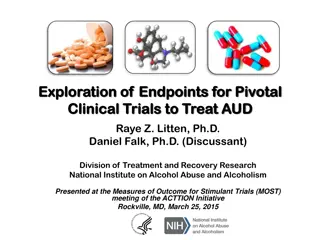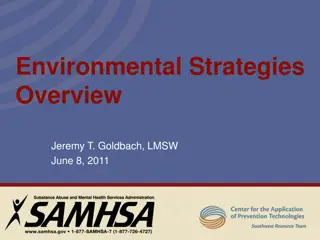Alcohol: Your Poison and How it Affects Your Body
Alcohol, a popular social lubricant, has both short-term and long-term effects on the human body. From how alcohol enters the body to its impact on different organs and systems, this content sheds light on various aspects of alcohol consumption. Exploring the absorption process, effects on behavior, and potential dangers associated with excessive drinking, this informative piece provides insights into the influence of alcohol on our health and well-being.
Download Presentation

Please find below an Image/Link to download the presentation.
The content on the website is provided AS IS for your information and personal use only. It may not be sold, licensed, or shared on other websites without obtaining consent from the author.If you encounter any issues during the download, it is possible that the publisher has removed the file from their server.
You are allowed to download the files provided on this website for personal or commercial use, subject to the condition that they are used lawfully. All files are the property of their respective owners.
The content on the website is provided AS IS for your information and personal use only. It may not be sold, licensed, or shared on other websites without obtaining consent from the author.
E N D
Presentation Transcript
Pain Management for the Pectus Nuss Patient: A Journey Barbara Combs RN, BSN, MSN, PNP-BC
Objectives 1. Concept of Evidence Based Practice 2. Anatomy of Pectus Procedures and pain 3. Importance of Pectus pain management 4. Pectus Nuss procedure 5. Ravitch procedure
Objectives 6. Post op goals of care 7. History of prior treatment 8. Establishment of a pain protocol 9. Team effort 10. Drugs of protocol 11. Results 12. Solutions
Introduction Idea of using a protocol for pain management Witnessing the amount of pain post op Wanting to provide adequate pain management and improve patient outcomes Improving patient experience and satisfaction
Introduction Successful management of a post procedural pain requires the use of numerous methods of pain control. These include epidural, PCA, NSAIDs and systemic opioids. This is the top priority and in turn effects patient satisfaction and can increase complication rates.
Evidence Based Practice By definition is using the best evidence possible with the most appropriate information available to make clinical decisions for individual patients and improve outcomes.
Steps: 1. Formulate the question/s that need answers to satisfy the specific patient needs. 2. Retrieval of the necessary information to answer the question 3. Reading and assessing the retrieved information to answer the question 4. Carry out a decision. 5. Evaluation of the process to determine if optimal outcomes were achieved.
Pathology of Pain A strong pain stimuli activates N- Methyl-D aspartate (NMDA) receptors and produce hyperexcitibility of dorsal root neurons. This trigger induces central sensitization leading to the wind up phenomenon and pain memory thus causing pain.
Nuss Procedure First performed in 1987 by Donald Nuss to correct the deformity of Pectus Excavatum or sunken chest Involves insertion of a metal bar into the chest under the defect and then flipping it causing the chest to be popped up into a more anatomical position. This causes a dislocation and realignment of the costovertebral joints with the chest reposition.
Pectus Pain Pathology By abruptly elevating the sternum anteriorly a substantial amount of pain in the chest and back is generated in a skeletally mature adolescent. The pressure of the bar holding the chest in a new elevated position increases the magnitude of pain involving the dermatomes of T1-T10.
Ravitch Procedure A transverse incision is made between the nipples, and the offending costal cartilage is removed with remodeling of the sternum and then placement of the bar for stabilization. Sutures are then placed around the bar to secure it to the ribs. The bar remains in place for about 12 months. You are not able to see the bar on the outside of the chest.
As you can imagine these patients are in immense pain. The post op goals of care are pain management. Prior to the establishment of the pain protocol, these patients had a rough post op course and usually had problems through out their hospitalization and at home as well.
The prior treatment of pain for these patients was MD dependent so drug choice were just for pain without the understanding of the other pain experienced by the patient. Meaning the muscle pain and inflammation caused by the readjustment of the ribs and cartilage.
Pain Protocol Mission and goal of this was to anticipate and effectively treat post procedure pain and discomfort. This was a team effort with input from pharmacy, anesthesia and nursing.
Pectus Order Set POD 0 Ketorolac (Toradol) Methocarbamol (Robaxin) IV Ondansetron (Zofran) Famotidine (Pepcid) Epidural POD 2 Oxycodone/acetamin ophen (Percocet) oxycodone (Oxycontin) Ibuprofen Methocarbamol (Robaxin) po Famotidine (Pepcid) po Miralax
Pain Protocol Drugs Famotidine/Pepcid Prophylaxis: for gastric upset due to NSAID therapy Duration of therapy: 1 month post op Adverse Rx: dizziness, headache, constipation, diarrhea Dose 20 mg BID for 1 month
Pain Protocol Drugs Famotidine/Pepcid MOA: inhibits histamine at H2 receptors and gastric parietal cells inhibiting gastric secretion Onset: 1 hour Max: 30 minutes (IV) 1-4 hours (oral) Duration: 10-12 hours
Pain Protocol Drugs Ibuprofen Anti inflammatory Nsaid Duration of therapy: 1 month post op Adverse Rx: increased risk of gastrointestinal bleeding and perforation Dose: 10 mg/kg Q 6 hours
Pain Protocol Drugs Ibuprofen MOA: inhibits cyclooxygenase 1&2 (Cox 1&2) enzymes decreasing the formation of prostaglandin precursors, has antipyretic, analgesic and anti inflammatory effects Onset 1 hour Max: 2-4 hours Duration: 6-8 hours (dose related)
Pain Protocol Drugs Ketorolac/Toradol Non narcotic anti inflammatory agent, Nsaid Duration of therapy: POD 0 and POD 1 Adverse Rx: edema, hypotension, dizziness, drowsiness, headache Dose: every 6 hours for 24 hours post op then replaced with ibuprofen every 6 hours
Pain Protocol Drugs Ketorolac/Toradol MOA: inhibits Cox 1&2 enzymes, decreases formation of prostaglandin precursors, antipyretic, analgesic, anti inflammatory Onset: 30 minutes (IV) Max: 2-3 hours (IV) Duration: 4-6 hours
Pain Protocol Drugs Methocarbamol/Robaxin Treatment of muscle spasms associated with acute painful musculoskeletal conditions Duration of therapy: 1 month post op Adverse Rx: bradycardia, flushing, hypotension, syncope, dizziness, drowsiness, fever, headache Dose:15mg/kg/dose IV Q 6 hours POD0&1 then po
Pain Protocol Drugs Methocarbamol/Robaxin MOA: causes skeletal muscle relaxation by general CNS depression Onset: 30 minutes Max: 1-2 hours Duration: 1-2 hours
Pain Protocol Drugs Oxycodone/Oxycontin Used for around the clock management of moderate to severe pain when analgesic is needed for long period of time Duration of therapy: starts POD 2 and continues for 1 week after discharge Adverse Rx: orthostatic hypotension, drowsiness, dizziness, anxiety, chills, confusion, nervousness, twitching, abdominal pain, gastritis, vomiting and constipation
Pain Protocol Drugs Oxycodone/Oxycontin Dose: 10 mg Q 12 hours MOA: binds to opiate receptors in CNS, inhibiting ascending pain pathways, altering perception and response to pain produces generalized CNS depression Onset: 12 hours Max: 12 hours Duration: 12 hours
Percocet Percocet Pain spike Pain spike Oxycontin
Pain Protocol Drugs Oxycodone with Acetaminophen Relief of moderate to moderately severe pain Duration of therapy: 1 week post op Adverse Rx: circulatory depression, hypotension, dizziness, drowsiness, fatigue, headache, insomnia, skin rash, constipation, nausea and vomiting Dose: 1-2 Norco 5 Q 4-6 hours prn
Pain Protocol Oxycodone with Acetaminophen MOA: blocks pain perception in cerebral cortex by binding to specific receptor molecules and opiate receptors within neuronal receptors decreasing synaptic chemical transmission throughout CNS inhibiting flow of pain sensations in the higher centers Onset: 10-15 minutes Max: 60 minutes Duration: 3-6 hours
Pain Protocol Drugs Polyethylene Glycol 3350/Miralax Use as an osmotic laxative, prophylactic with narcotic use Duration of therapy: 1 month post op Adverse Rx: urticaria, abdominal bloating, cramping, diarrhea, flatulence, nausea Dose: 17gm daily
Pain Protocol Drugs Polyethylene Glycol 3350/Miralax MOA: osmotic agent causes water retention into stool increasing stool frequency Onset: 1-3 days
Pain Protocol Drugs Morphine Management of severe acute pain Duration of therapy: during hospitalization as PCA or prn dosing Adverse Rx: bradycardia, flushing, syncope, amnesia, agitation, anxiety, drowsiness, slurred speech, pruritus, rash, urticaria, constipation, nausea, vomiting, urinary retention, respiratory depression
Pain Protocol Drugs Morphine Dose: PCA or 2 mg Q 2-3 prn MOA: binds to opioid receptors in CNS causing inhibition of ascending pain pathways altering perception and response to pain producing generalized CNS depression Onset: 20 minutes Duration: 3-5 hours
Results The degree of pain affects all measureable objective outcomes during their hospitalization Parents during hospitalization are asked about the control of their child s pain and for 2015 the average is 88% controlled In patients less than age 12 or 40 kg Oxycontin is not used
Results If they have a reaction to Oxycontin it is discontinued and the patient is monitored closely and alternate methods are use to control pain A future study is being researched at the present time If the Oxycontin causes over sedation it is held and other meds are added as needed
Results Have only had 2 patients who developed gastric upset with the ibuprofen, so Pepcid became standard Constipation is averted with Miralax and if problems MOM is given and if no results suppository is next step
References Anguole, D, Rugyte,C, Kilds, A, Karbonskiene, A, Mantas,V, Drauskas, B. ( 2010 ). Systemic post operative pain management following minimally invasive pectus excavatum repair in children and adolescents: a retrospective comparison of intravenous patient controlled analgesia and continuous infusion with morphine. Pediatric Surgery International. 26:665-69 Butkovic,D, Kralik,S, Matolic, M, Kralik, S,Toljan, L. Radesic. (2007). Post operative analgesia with intravenous fentanyl PCA vs. epidural block after thoracoscopic pectus excavatum repair in children. British Journal of Anaesthesia. 98(5):677-81. Chia, m., Eom, J., Lee, Y., Kim, W., Park, Y., Min, S., Kim, J., (2012). Beneficial effects of adding ketamine to intravenous PCA with fentanyl after the Nuss procedure in pediatric patients. Yonsei Medical Journal. 53(2): 427-32.
References Cucchiaro, G., Adzick, S., Rose, J., Maxwell, L., Watcha, M. (2006). A comparison of epidural bupivacaine-fentanyl and bupivacaine- clonidine in children undergoing the Nuss procedure. Anesthesia and Analgesia. 103(2):322-27. Densmore, D., Peterson, D., Stahovic, M., Czarnecki, M., Hainsworth, K., Davies, H., Cassidy, L., Weisman, S., Oldham, K., (2010) Initial surgical and pain management outcomes after the Nuss procedure. Journal of Pediatric Surgery. 45:1767-71. Gasior, A., Weesner, K., Knott, M., Poola, A., St Peter, S. (2013). Long term patient perception of pain control experience after participating in a trial between PCA and epidural after pectus excavatum repair with bar placement. Journal of Surgical Research. 185: 12-14.
References Ghionzoli, M., Brandigi, E., Messineo, A., Messeri, A. (2012). Pain and anxiety management in minimally invasive repair of pectus excavatum. Korean Journal of Pain. 25(4): 267-71. Grol, R., Wensing, M. What drives change? Barriers to and incentives for achieving evidence based practice. (2004). Medical Journal of Australia. 180:557-60. Grosen, K., Pfeiffer-Jenson, M., Pilegaard, H. (2010). Post operative consumption of opioid analgesics following correction of pectus excavatum is influenced by pectus severity: a single centre study of 236 patients undergoing minimally invasive correction of pectus excavatum. European Journal of Cardiothoracic Surgery. 37:833-39. Ivani, G., Mosseti, V. (2010). Continuous central and perineural infusions for post operative pain control in children. Current Opinion in Anaesthesilolgy. 23:637-42.
References Kokinsky, E., Thornberg, E. (2003). Post op pain control in children: a guide to drug choice. Pediatric Drugs. 5(11): 751-62. Lee, J., Jo, Y. (2014). Attention to post operative pain control in children. Korean Journal of Anesthesiology. 66(3): 183-88. McDonald, A., Cooper, M. (2001). Patient-controlled analgesia: an appropriate method of pain control in children. Paedratric Drugs. 3(4): 273-84. McKibbon, A. (1998). Evidence based practice. Bull Medical Library Association. 86(3): 396-401. Nuss, D. (2008). Minimally invasive surgical repair of pectus excavatum. Seminars In Pediatric Surgery. 17:209-17.
References Pilegaard,H., Grosen, K. (2010). Postoperative pain location following the Nuss procedure what is the evidence and does it make a difference. European Journal of Cardiothoracic Surgery. 38:203-09. St Peter, S., Weesner, K., Sharp, R., Sharp, S., Ostlie, D., Holcomb, G. (2008). Is epidural anesthesia truly the best pain management strategy after minimally invasive pectus excavatum repair. Journal of Pediatric Surgery. 43:70-82. St Peter, S., Weesner, K., Weissend, E., Sharp, S., Valusek, P., Sharp, R., Snyder, C., Holcomb, G., Ostlie, D. (2012). Epidural vs. patient controlled analgesia for post operative pain after pecus excavatum repair: a prospective randomized trial. Journal of Pediatric Surgery. 47:148-53. Taketomo C., Hodding J., Kraus, D., (2015). Robaxin dosing. Pediatric and Neonatal Dosage Handbook A Comprehensive Resource for all Clinicians Treating Pediatric and Neonatal Patients. 1387-89.
References Taketomo C., Hodding J., Kraus, D., (2015). Toradol dosing. Pediatric and Neonatal Dosage Handbook A Comprehensive Resource for all Clinicians Treating Pediatric and Neonatal Patients. 1192-95. Taketomo C., Hodding J., Kraus, D., (2015). Oxycontin dosing. Pediatric and Neonatal Dosage Handbook A Comprehensive Resource for all Clinicians Treating Pediatric and Neonatal Patients. 1509-94. Taketomo C., Hodding J., Kraus, D., (2015). Percocet dosing. Pediatric and Neonatal Dosage Handbook A Comprehensive Resource for all Clinicians Treating Pediatric and Neonatal Patients. 1594-97. Taketomo C., Hodding J., Kraus, D., (2015). Ibuprofen dosing. Pediatric and Neonatal Dosage Handbook A Comprehensive Resource for all Clinicians Treating Pediatric and Neonatal Patients. 1044-71.
References Taketomo C., Hodding J., Kraus, D., (2015). Miralax dosing. Pediatric and Neonatal Dosage Handbook A Comprehensive Resource for all Clinicians Treating Pediatric and Neonatal Patients. 1724 Taketomo C., Hodding J., Kraus, D., (2015). Pepcid dosing. Pediatric and Neonatal Dosage Handbook A Comprehensive Resource for all Clinicians Treating Pediatric and Neonatal Patients. 847-50. Taketomo C., Hodding J., Kraus, D., (2015). Morphine dosing. Pediatric and Neonatal Dosage Handbook A Comprehensive Resource for all Clinicians Treating Pediatric and Neonatal Patients. 1461-70. Wong, C., Lau, E., Palozzi, L., Campbell, F. (2012). Pain management in children: part 1 pain assessment tools and brief review of nonpharmacologic and pharmacological treatment options. CPJ/RPC. 145(5):222-25.
